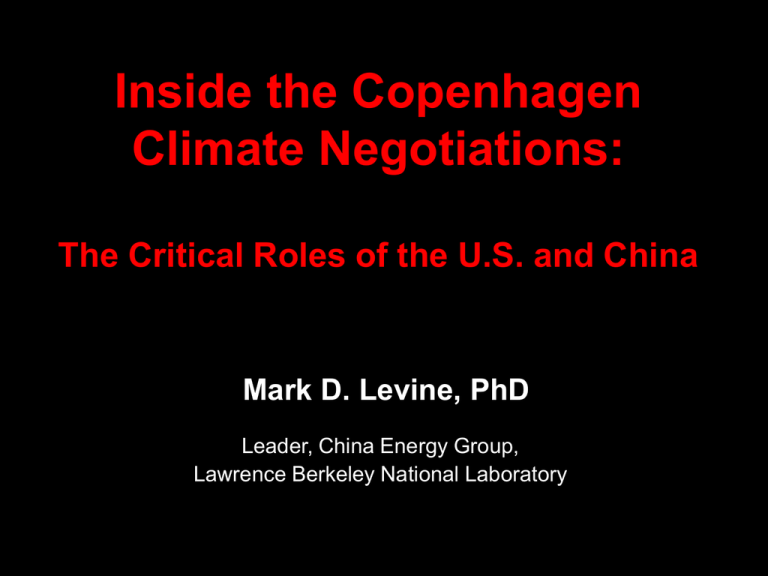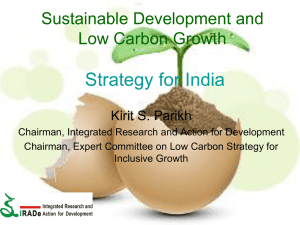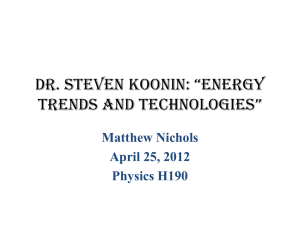Myth - China-US Energy Efficiency Alliance
advertisement

Inside the Copenhagen Climate Negotiations: The Critical Roles of the U.S. and China Mark D. Levine, PhD Leader, China Energy Group, Lawrence Berkeley National Laboratory China Energy Group at Lawrence Berkeley National Lab 劳伦斯伯克利国家实验室 中国能源研究室 • Established 1988 成立于1988年 • Unique in the world 有独特的优势 • Mission: China Energy Group works collaboratively with groups in China and elsewhere to: 宗旨:通过与中国和其他地区的机构的合作来: -- enhance the capabilities of Chinese institutions that promote energy efficiency and 加强中国促进能效的机构的能力建设 -- understand the dynamics of energy use in China. 2 Key Successes 主要成就 • Driving force for Chinese adoption of appliance energy efficiency standards 中国采用家电能效标准的主要推动力 • Performed pilot project of industry efficiency agreements as a forerunner to China’s national industrial energy efficiency policy 作为先行者开展工业 能效协议试点项目 • Created two institutions that are leaders in energy efficiency policy: the Energy Foundation China Sustainable Energy Program (in SF) and the Beijing Energy Conservation Center (in Beijing) 建立了两个能效 政策的领导性机构:能源基金会中国可持续能源项目(在旧 金山)和北京能源效率中心(北京) • Trained more than 300 Chinese in various aspects of energy efficiency 在能效的各方面国内培训人员超过300人 3 The key parties to the negotiation: 1. United States 2. China 3. European Union 4. Developing World Two parties will set the tone: U.S. and China E. U. and developing countries will be very active in discussions but will follow the lead of the U.S. and China. China has committed to a 40-45% reduction in its CO2 emission intensity relative to 2005 intensity levels. The U.S. cannot make an official commitment, because this will require Congressional action. But President Obama can and will state his position on greenhouse gas limits. As a consequence, Copenhagen is likely to serve as a basis for official decisions that will take place on or before the 2010 meeting of the Conference of the Parties (COP) in Mexico. Question: what is the significance of the 40%-45% reduction in CO2 emissions intensity in China? Note: CO2 emissions intensity – CO2/unit gross domestic product (GDP) Background on Energy and Carbon Dioxide Emissions in China China’s Energy & Economic Growth 1,000 900 800 1980 = 100 700 600 GDP 500 国内生产总值 400 300 200 Energy 100 0 1980 能源消费 1985 Source: China Energy Group, Lawrence Berkeley National Laboratory 1990 1995 2000 However, from 2003-2005, energy intensity increased for the first time since 1980 with very significant consequences Annual CO2 Emissions: US & China million tons carbon dioxide 6,000 5,000 US 4,000 3,000 China 2,000 1,000 0 1980 1985 1990 1995 2000 2005 Source: US annual emissions amounts reported by US EIA in the 2006 Annual Energy Review and 2007 Flash Estimate; China emissions are derived from revised total energy consumption data published in the 2007 China Statistical Yearbook using revised 1996 IPCC carbon emission coefficients by LBNL Nonetheless Global, Chinese & U.S. Per-Capita Energy-Related CO2 Emissions – 1950-2004 tons CO2/person 25 US 美国 20 15 10 Global Average 全球平均 5 China 中国 0 1950 1956 1962 1968 1974 1980 1986 1992 1998 2004 Source: China emissions are derived from revised total energy consumption data published in the 2007 China Statistical Yearbook using revised 1996 IPCC carbon emission coefficients by LBNL; China population data from NBS and US Census (for 1950-51); global and American emissions data from Oak Ridge National Laboratory, Carbon Dioxide Information Analysis Center; global and American population data from US Census • Recent newspaper articles state that China’s commitment to reduce CO2 emissions intensity by 40% to 45% by 2020 is of little significance. • I respectively disagree. • Judged by the standards of all other developing countries, China’s commitment is very significant • Achieving the goal of 40-45% reduction in CO2 by 2020 will require very significant policies for China to contain the economic forces that are driving energy demand • Restraining these forces will require continued application of very stringent policies • • • • • Tougher efficiency standards—for appliances and for motor vehicles--than those in the U.S. More low or zero carbon energy sources per capita than any country except France or a hydropower-rich nation Greater investment in wind, photovoltaics, nuclear power than any country (even on a per capita basis) Among the highest energy prices in the developing world Most importantly, If the developing world were able to achieve China’s target, projected global CO2 emissions would be cut by 50 to 75%world were able to follow China’s example (40-45% intensity reduction for 2020), then global emissions growth through 2020 would be cut by more than 50% from • It is a common belief that China’s CO2 emissions will continue to grow throughout this century and will dominate the world’s emissions. We believe this is not likely to be the case because: – Appliances, floor area, vehicles, roadways, etc. will saturate some time between 2020 and 2030 – When this happens, China will have (on a total and per capita basis) larger low or zero CO2 emissions energy supply system than the United Statest United States by a considerable margin • Unless the Chinese develop a profligate lifestyle—modeling themselves on a certain country in North America—China will have leveled off in its CO2 emissions at a much lower per capita level than the United States, Europe, or Japan!! Thank you! Mark Levine MDLevine@lbl.gov Myths Not used in presentation; included in case there are questions that can best be answered by a power point. My topic concerns the myths – often pernicious – surrounding China’s energy demand, supply, prices and associated CO2 emissions 我的主题是关于关于中国能源需求、 供给、价格和相关二氧化碳排放的迷 思,这些迷思通常是有害无益的 Myth: China has paid little attention to energy efficiency, preferring to build countless coal-fired power plants instead 迷思: China’s Energy & Economic Growth 中国的能源消费与经济增长 1,000 900 800 1980 = 100 700 600 GDP 500 国内生产总值 400 300 200 Energy 100 0 1980 能源消费 1985 Source: China Energy Group, Lawrence Berkeley National Laboratory 数据来源:劳伦斯-伯克利国家实验室,中国能源与环境研究室 1990 1995 2000 Industrial Energy Intensities are Declining 工业能源强度正在下降 /2000 千 克 标 准 煤 年 人 民 币 元 2.0 Smelting & rolling of ferrous metals 1.8 金属冶炼及压延加工 1.6 1.4 Petroleum refining & coke production 1.2 Non-metal mineral products 1.0 非金属矿物制品 Non-ferrous metals mining and casting 0.8 kgce/RMB (2000) Chemicals 化工 Paper 造纸 0.6 0.4 0.2 Coal mining Electricity production 电力 Textiles 纺织 0 Source: China Energy Group, Lawrence Berkeley National Laboratory 资料来源:劳伦斯-伯克利国家实验室,中国能源与环境研究室 Improving energy efficiency in industry is crucial because industry is 70% of total energy demand Note: comparisons of CO2 emissions are on a per capita basis This is the only measure that makes sense. Would you compare Monaco and the United States based on total CO2 emissions, or on per capita emissions? Myth: China, because of its enormous coal use, has emitted more CO2 than any other nation Global, Chinese & U.S. Per-Capita Energy-Related CO2 Emissions – 1950-2004 1950-2004年全球、中国和美国的人均能源相关二氧化碳排放量 US 美国 tons CO2/person / 吨 二 氧 化 碳 人 Global Average 全球平均 China 中国 Myth: China’s per capita coal consumption is the highest in the world Per Capita Coal Consumption, Various Countries 不同国家的人均煤炭消耗 / 人 均 煤 炭 消 耗 ( 吨 石 油 当 量 每 人 ) Myth: China’s vast coal reserves, which it is bound to use, will swamp any effort to tackle global climate / 人 均 煤 炭 探 明 储 量 ( 吨 每 人 ) Per-Capita Proven Coal Reserves (tonnes/person) Per Capita Coal Reserves, Various Countries 不同国家的人均煤炭数量 4000 3,645 3500 3000 2500 2,022 2000 1500 1000 500 0 1,109 1,009 805 730 400 197 50 37 Myth: China is hogging the world’s oil imports Global Oil Supply (blue), Traded oil (light blue), Chinese oil consumption (red), Chinese oil imports (yellow) 世界石油供给(蓝色),石油贸易(浅蓝色),中国石油消 耗(红色),中国石油进口(黄色) 90 World Demand 全球需求量 80 World Oil Trade 全球石油贸易量 China Demand 中国石油需求量 China Net Imports 中国石油净进口 60 50 40 30 20 10 - 2007 2006 2005 2004 2003 2002 2001 2000 1999 1998 1997 1996 1995 1994 1993 1992 1991 -10 1990 / 百 万 桶 石 油 每 天 million barrels/day 70







